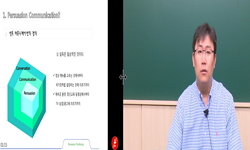The purpose of this study is to inquire into the persuasive means shown in Poymun of Koryo History. Among them, this study is focused on the methods contributing the figurative expression to the persuasion. That is to break away from the point of vi...
http://chineseinput.net/에서 pinyin(병음)방식으로 중국어를 변환할 수 있습니다.
변환된 중국어를 복사하여 사용하시면 됩니다.
- 中文 을 입력하시려면 zhongwen을 입력하시고 space를누르시면됩니다.
- 北京 을 입력하시려면 beijing을 입력하시고 space를 누르시면 됩니다.
https://www.riss.kr/link?id=A76456153
- 저자
- 발행기관
- 학술지명
- 권호사항
-
발행연도
2007
-
작성언어
-
- 주제어
-
KDC
811
-
등재정보
KCI등재
-
자료형태
학술저널
-
수록면
71-88(18쪽)
- 제공처
-
0
상세조회 -
0
다운로드
부가정보
다국어 초록 (Multilingual Abstract)
The subject of this study is figurative expressions shown in Pyomun of Koryo History. And this study intends to indicate that figurative expressions contribute to a persuasive function in addition to a decorative function in communication situations. Nevertheless it is not to say that the decorative function of figurative expressions is meaningless in a text. Besides it needs only to bring another essential aspect as well as the aesthetic nature to light.
There are a variety of figurative expressions contributing to persuasion in Pyomun. This means of expression are a question rhetoric, a simile, an antithesis, a metonymy, and a metaphor. The figurative expressions have an influence on literary decoration on the one hand and indirectly on persuasion on the other hand.
First, a question rhetoric expresses the contents of communication in an indirect method. In other words, a speaker persuades effectively a listener being not in a bad temper the listener because of a strong assertion or making merely his subjective assertion an objective fact.
Second, a simile appears clearly the speaker’s mind that he praises and approves the act of the listener. This expression results in the effectiveness of transmission that the speaker makes clear and effectual the content of the admiration for the listener.
Third, an antithesis produces an effect on raising vividly the opinion and assertion that the speaker wants to communicate. It makes universal validity of the opinion intending to transmit and makes good progress effectively for persuasion.
Fourth, a metonymy is used when the speaker expresses the best admiration for the listener. It makes ultimately an effect on gaining the listener’s confidence and favorable impression.
Finally, a metaphor transmits a plentiful meaning through a brief figure of speech. Also the metaphor used in Poymun is formally short. Yet the speaker shows oneself a modest attitude while the listener shows a noble person by the brief metaphor. Therefore it is very effective by means of persuasion through both humility and politeness.
The purpose of this study is to inquire into the persuasive means shown in Poymun of Koryo History. Among them, this study is focused on the methods contributing the figurative expression to the persuasion. That is to break away from the point of view that a figurative expression makes flowery words and has aesthetically the decorative function, and to examine from the viewpoint that it is the essence of a language and at the same time the constituent element of thought. In this manner, this study takes a view of a figurative expression in terms of the function of a rhetoric persuasion as a possibility with the view to nonexistent the inherent recognition devoid of a figurative expression.
The subject of this study is figurative expressions shown in Pyomun of Koryo History. And this study intends to indicate that figurative expressions contribute to a persuasive function in addition to a decorative function in communication situations. Nevertheless it is not to say that the decorative function of figurative expressions is meaningless in a text. Besides it needs only to bring another essential aspect as well as the aesthetic nature to light.
There are a variety of figurative expressions contributing to persuasion in Pyomun. This means of expression are a question rhetoric, a simile, an antithesis, a metonymy, and a metaphor. The figurative expressions have an influence on literary decoration on the one hand and indirectly on persuasion on the other hand.
First, a question rhetoric expresses the contents of communication in an indirect method. In other words, a speaker persuades effectively a listener being not in a bad temper the listener because of a strong assertion or making merely his subjective assertion an objective fact.
Second, a simile appears clearly the speaker’s mind that he praises and approves the act of the listener. This expression results in the effectiveness of transmission that the speaker makes clear and effectual the content of the admiration for the listener.
Third, an antithesis produces an effect on raising vividly the opinion and assertion that the speaker wants to communicate. It makes universal validity of the opinion intending to transmit and makes good progress effectively for persuasion.
Fourth, a metonymy is used when the speaker expresses the best admiration for the listener. It makes ultimately an effect on gaining the listener’s confidence and favorable impression.
Finally, a metaphor transmits a plentiful meaning through a brief figure of speech. Also the metaphor used in Poymun is formally short. Yet the speaker shows oneself a modest attitude while the listener shows a noble person by the brief metaphor. Therefore it is very effective by means of persuasion through both humility and politeness.
목차 (Table of Contents)
- 1. 들어가기
- 2. 표문과 설득
- 3. 『고려사』 소재 표문의 비유적 표현과 설득
- 4. 결론
- 참고문헌
- 1. 들어가기
- 2. 표문과 설득
- 3. 『고려사』 소재 표문의 비유적 표현과 설득
- 4. 결론
- 참고문헌
동일학술지(권/호) 다른 논문
-
장정일의 글쓰기 방법 - 희곡 『일월』과 소설 『중국에서 온 편지』를 중심으로
- 동남어문학회
- 양정임(Yang Jung-Im)
- 2007
- KCI등재
-
- 동남어문학회
- 정규식(Chung Ku-Sik)
- 2007
- KCI등재
-
『花開』에 드러난 시적언어와 사상의 문제 - 〈不然其然〉과 〈和諍〉의 논리를 중심으로
- 동남어문학회
- 정훈(Jeong Hoon)
- 2007
- KCI등재
-
- 동남어문학회
- 한영란(Han Yeong-Rran)
- 2007
- KCI등재





 스콜라
스콜라




